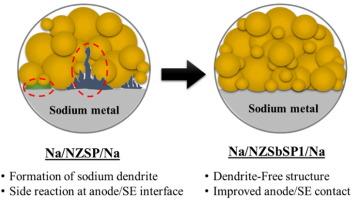用于稳定固态钠电池的无枝晶掺杂nasicon型Na3Zr2Si2PO12固体电解质
IF 13.2
1区 工程技术
Q1 ENGINEERING, CHEMICAL
引用次数: 0
摘要
固态钠电池(SSSBs)因其操作安全、能量密度高、原料丰富等优点而备受关注。然而,固体电解质(SEs)对Na枝晶的高电阻、低离子电导率和有限的耐受性是其商业化的最大障碍。在这项研究中,我们首次合成了一种sb掺杂的Na3Zr2Si2PO12 (NZSP)。在1200 ℃下烧结得到的最佳Na3.1Zr1.9Sb0.1Si2PO12 (NZSbSP)具有更好的na离子电导率、较高的相对密度和优异的电化学稳定性。此外,对称电池操作显示了与Na金属的良好相容性,Na0.9Zn0.22Fe0.3Mn0.48O2/NZSbSP/Na SSSB在0.1C和25 °C下循环50次后具有优异的电化学性能,保留率为93.70 %。此外,使用扫描电子显微镜和x射线光电子能谱在三个不同的阶段对废Na金属和SEs进行尸检研究:(i)原始,(ii)接触Na金属后,(iii) 30次循环后。NZSbSP相对密度的提高抑制了镀层和剥离过程中Na枝晶的生长。这证实了Sb掺杂的NZSP在提高NASICON se的离子电导率和抑制实际sssb中Na枝晶形成方面的有效性。本文章由计算机程序翻译,如有差异,请以英文原文为准。

Dendrite-free Sb-doped NASICON-type Na3Zr2Si2PO12 solid-electrolyte for stable solid-state sodium batteries
Solid-state sodium batteries (SSSBs) are gaining attention because of their safe operation, high energy density, and abundant raw materials. However, the high resistance, low ionic conductivity, and limited tolerance of solid electrolytes (SEs) to Na dendrites are the biggest obstacles for their commercialization. In this study, we synthesize a Sb-doped Na3Zr2Si2PO12 (NZSP) for the first time. The optimal Na3.1Zr1.9Sb0.1Si2PO12 (NZSbSP) sintered at 1200 °C exhibits improved Na-ion conductivity, high relative density, and excellent electrochemical stability. Moreover, the symmetry cell operation demonstrates exceptional compatibility with Na metal, and the Na0.9Zn0.22Fe0.3Mn0.48O2/NZSbSP/Na SSSB exhibits superior electrochemical performance, with a retention of 93.70 % after 50 cycles at 0.1C and 25 °C. Additionally, a postmortem study of the spent Na metal and SEs is performed using scanning electron microscopy and X-ray photoelectron spectroscopy at three different stages: (i) pristine, (ii) after contact with Na metal, and (iii) after 30 cycles. The improved relative density of NZSbSP suppresses the growth of Na dendrites during plating and stripping. These confirm the effectiveness of the Sb doping of NZSP in improving the ionic conductivity of NASICON SEs and suppressing Na dendrite formation for practical SSSBs.
求助全文
通过发布文献求助,成功后即可免费获取论文全文。
去求助
来源期刊

Chemical Engineering Journal
工程技术-工程:化工
CiteScore
21.70
自引率
9.30%
发文量
6781
审稿时长
2.4 months
期刊介绍:
The Chemical Engineering Journal is an international research journal that invites contributions of original and novel fundamental research. It aims to provide an international platform for presenting original fundamental research, interpretative reviews, and discussions on new developments in chemical engineering. The journal welcomes papers that describe novel theory and its practical application, as well as those that demonstrate the transfer of techniques from other disciplines. It also welcomes reports on carefully conducted experimental work that is soundly interpreted. The main focus of the journal is on original and rigorous research results that have broad significance. The Catalysis section within the Chemical Engineering Journal focuses specifically on Experimental and Theoretical studies in the fields of heterogeneous catalysis, molecular catalysis, and biocatalysis. These studies have industrial impact on various sectors such as chemicals, energy, materials, foods, healthcare, and environmental protection.
 求助内容:
求助内容: 应助结果提醒方式:
应助结果提醒方式:


